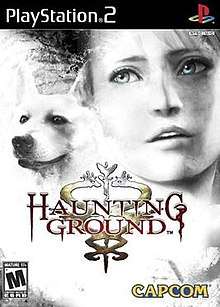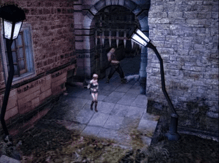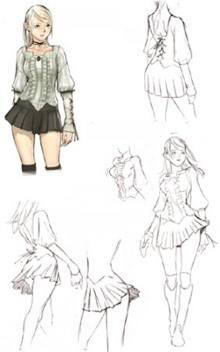Haunting Ground
Haunting Ground, known in Japan as Demento,[lower-alpha 1] is a survival horror video game developed and published by Capcom for the PlayStation 2 in 2005. The story follows Fiona Belli, a young woman who wakes up in the dungeon of a castle after being involved in a car accident. She quickly befriends a White Shepherd, Hewie, and begins to explore the castle with his aid to seek a means of escape and unravel the mysteries of it and its inhabitants. The game shares many similarities with Capcom's earlier survival horror title Clock Tower 3 (2002), and has been described as a spiritual successor to the Clock Tower series.
| Haunting Ground | |
|---|---|
 North American box art | |
| Developer(s) | Capcom |
| Publisher(s) | Capcom |
| Director(s) | Kazuhiro Tsuchiya |
| Producer(s) | Koji Nakajima |
| Designer(s) | Yukio Ando |
| Programmer(s) | Jun Takahashi |
| Writer(s) |
|
| Composer(s) |
|
| Platform(s) | PlayStation 2 |
| Release | |
| Genre(s) | Survival horror |
| Mode(s) | Single-player |
The player controls Fiona as she explores the environment, evades and hides from enemy pursuers, and occasionally fights against the castle's inhabitants. Sometimes Fiona will panic when in danger, in which case she begins to run on her own and the player loses some control. Hewie is a central part to the gameplay, and accompanies Fiona throughout the game. He can be given orders to explore the environment, attack enemies, and otherwise aid in Fiona's survival. Capcom added the dog mechanic during development thinking retailers and players alike would not enjoy a survival horror title with a lone female protagonist.
Haunting Ground was first revealed in September 2004, and was released next April garnering mixed to average reviews. The graphics and presentation were praised, but critics found the gameplay somewhat repetitive, predictable, and derivative of previous horror titles. The game's voyeuristic nature and the sexual objectification of Fiona were highlighted by critics as some of the game's best elements. They felt that by exposing Fiona as a vulnerable object of desire, the game makes her and therefore the player feel more fragile and endangered, building a more disturbing atmosphere. The fluctuating degree of player control over Fiona has made Haunting Ground a key subject in the study of avatars and their relationship with players in video games.
Gameplay

Haunting Ground is a survival horror game with similar gameplay elements to Clock Tower 3 (2002). The player controls Fiona Belli directly and gives commands to her canine companion, Hewie.[1] Fiona can run and perform a backstep maneuver, both of which reduce stamina. She can also crouch down to hide from enemy pursuers. Fiona can kick and tackle enemies as well, but tackling also reduces stamina.[2]:12–13 Losing too much stamina will result in Fiona becoming exhausted, causing her movements to slow down or possibly stop altogether. Exhaustion can be revived with certain items or with time.[2]:14–15 Fiona can interact with the environment by checking items, opening doors, and climbing ladders.[2]:12–13 The player can utilize hiding spots to evade pursuers. Other areas act as retaliation points that allow Fiona to use her environment to counterattack against her enemy, although some of these locations can only be used once.[2]:18–19
Commanding Hewie is an integral part of Haunting Ground's gameplay.[3] At the beginning of the game, he won't be completely friendly and obey all of Fiona's commands. The player has to build a friendship and gain his trust in order to survive the game.[2]:16–17 Hewie can be told to sniff out items, check suspicious areas or items, attack an enemy, or called back to Fiona's side.[2]:12–13,16–17 The player can praise Hewie by petting and feeding him, both of which can heal his vitality.[2]:12–13,20–21 Likewise, he can be scolded when he won't listen to commands. He can be told to "stand ready" before attacking, which increases his attack power.[2]:16–17
Enemies can hear footsteps and other sounds.[2]:22–23 When Fiona is in a dangerous situation, she may fall into a panic. During panic mode, visibility gets worse, the menu can't be opened, and she will begin running on her own, tripping and falling into walls. Panic mode will elapse after some time, or certain items can be used to calm her down. There are glowing orbs called "Luminescents", which will put Fiona in a state of panic and attract enemies to her. If Fiona sustains a significant amount of damage, she will slow down and become unable to backstep. If she receives too much damage she can die. Damage heals with time or items can be used to bring her vitality back to normal.[2]:14–15 While some items are used to heal Fiona and Hewie, others are used to damage enemies. Some can be thrown while others are set like traps for the enemy to walk over.[2]:18–19 Some items are found by searching while others can be crafted in refining rooms.[2]:20–21
Plot
Fiona Belli is an 18-year-old girl who recently moved to college. While visiting her parents, she is involved in a car accident, and awakens in a cage in the dungeon of a castle. Her memories of the incident are hazy. Noting that the cage that keeps her prisoner has been left unlocked, she steps out and begins searching for answers and a way out of the castle. Soon after, she befriends a White Shepherd named Hewie. As Fiona begins to unravel the mystery in which she finds herself, she learns that she is the carrier of the Azoth, an alchemic element, which for unknown reasons is being sought by Riccardo, the castle's keeper.
The first enemy Fiona encounters is Debilitas, a large, mentally disabled groundskeeper who thinks of Fiona as one of his dolls. Fiona learns from a mysterious man named Lorenzo, that to escape the castle, she needs a staff from the chapel. However, upon taking the staff, Debilitas corners Fiona and Hewie, forcing a confrontation. They defeat Debilitas, but soon find their next enemy, Daniella, an icy maid. Daniella covets Fiona's ability to smell, taste, touch, feel, and "experience pleasure." She is especially jealous that Fiona can create life (via a fertile womb). Daniella is defeated when she is impaled with a shard from a ceiling window pane.
The third villain is Riccardo, who wields a flintlock pistol. For the majority of the game, Riccardo keeps his face hidden under a hood. Upon revealing himself however, Fiona is shocked to see her dead father's face. Riccardo reveals that he and her father, Ugo, are clones. He murdered Ugo in the car accident as revenge for leaving the castle and marrying Fiona's mother. He plans to use Fiona (by means of her womb and use of her Azoth) to bring about his own rebirth, so that he may live forever. As they fight atop a water tower, Hewie rescues Fiona by attacking Riccardo, causing him to fall from the summit.
The final enemy is Lorenzo, who seemed to be an ally, but who now menaces Fiona in several different forms. Fiona first meets him as an old, crippled man. He tells Fiona that Riccardo was always the problem child, and that he created both Riccardo and Ugo in an attempt to find a body with an Azoth which he could use to gain immortality. Ugo had the Azoth, but left the castle to marry Ayla. Now with Riccardo dead, Lorenzo believes that Fiona is his, so he can take the Azoth she inherited from her father. He chases after Fiona, but she is able to crush him in a rock press. However, she soon encounters a resurrected, youthful Lorenzo; the life energy he acquired from Riccardo's body has allowed him mastery over his own aging process. With the help of Hewie, Fiona causes Lorenzo to fall into a pit of lava. At this point, the castle begins to shake and collapse, and Lorenzo returns as a flaming skeleton. He chases Fiona as she heads for the exit, and attempts to block her escape, but as they reach the door, he finally dies, and Fiona and Hewie leave the castle.
Development and release
Capcom began development knowing they wanted to make a survival horror game with a lead female character. Believing that the female lead would not bode well with retailers and players alike, they added in a dog partner that could attack enemies. After this change, they further designed the gameplay around this partner mechanic.[6] The cinematics were directed by actor and director, Naoto Takenaka.[7] He directly supervised the motion capture performances used for all the characters, placing emphasis on dramatic performance.[8] He took inspiration from Universal Monsters such as Frankenstein and Bela Lugosi's Dracula.[9] Takenaka played the motion capture role for Riccardo, and Japanese actors Yasue Sato and Jiro Sato played Fiona and Debilitas respectively.[10] Rather than streaming audio files, the music for Haunting Ground was generated by using the PS2's built-in sounds. This way, the composers could easily change the tempo of the music during gameplay.[11]
On September 24, 2004, Capcom debuted Haunting Ground under its Japanese name Demento at the Tokyo Game Show after launching a teaser page on their official website two days prior.[13] The game was released in Japan on April 21, 2005,[14] and later in PAL territories on April 29, and in North America on May 10.[15][16] Critics described the game as a spiritual successor to the Clock Tower series, although it has never been officially declared as such.[4][17]
In July 2012, Haunting Ground appeared to be slated for a PlayStation 3 re-release as a "PS2 Classic", having been rated by the ESRB with Sony Computer Entertainment named as the publisher.[18] On April 21, 2015, it was re-released for the PlayStation 3 via the PlayStation Store exclusively in Japan.[19][20]
Reception
| Reception | ||||||||||||||||||||||||||||||||||
|---|---|---|---|---|---|---|---|---|---|---|---|---|---|---|---|---|---|---|---|---|---|---|---|---|---|---|---|---|---|---|---|---|---|---|
| ||||||||||||||||||||||||||||||||||
Haunting Ground received "mixed or average" reviews per ratings aggregator Metacritic.[21] Critics were quick to compare it to the Clock Tower series, specifically its 2002 installment, Clock Tower 3 (2002).[1][29][30] The defenseless heroine elements and hide-and-chase gameplay were found to be highly derivative of the former titles.[22][30] The dog companion was, for some, a well-received addition to the gameplay formula, with Eurogamer's Kristan Reed comparing it positively to Ico.[1][16] Others found the dog and other gameplay elements to be repetitive and contributors to poor pacing.[27][28][29] The graphics, cinematics, and atmosphere were universally praised.[3][16][22][27][29] The staff at 1UP.com described the environments as "some of the most detailed, lavish 3D environments Capcom has ever produced."[16][22][27] Kill Screen's Astrid Budgor compared Haunting Ground's "psychological landscape" to Dario Argento's film Suspiria (1977) and also highlighted its grotesque expressionism.[4] Despite these highlights, critics ultimately felt that Haunting Ground was too predictable and relied heavily on clichés previously established in the horror genre. For this reason, Reed said it "becomes stifled by its own eventual lack of ambition to break away from the norms instilled by two generations of Japanese horror adventures."[16][27] The staff at 1UP.com felt the game was dated when compared with the recently released Resident Evil 4 (2005), but said, "Haunting Ground isn't without merit, it's just that the merits are buried deep in an occasionally thrilling, mostly 'been there, done that' game of indistinct origin."[22]
Some critics highlighted Haunting Ground's sexual themes surrounding the objectification of Fiona as one of its best elements.[1][4][5][31] Jeremy Dunham of IGN stated that "Haunting Ground's success comes from making the player feel like a desired and endangered object." He found the plot was kept interesting due to the disturbing suggestive behaviors of Fiona's pursuers.[1] Kill Screen's Budgor also found the drive for the enemies to kill Fiona creates a continuous tension, as its unclear nature lends to an uncomfortable confusion for both Fiona and the player.[4] GameSetWatch's Leigh Alexander stated that "disparaging Haunting Ground for its copious objectification of women is a facile task...it’s precisely that off-putting sexuality that makes Daniela terrifying, that makes Fiona’s circumstances so explicitly repugnant, that sharpens Haunting Ground’s fear factor to a knife in the gut." Alexander praised the game's voyeuristic themes and presenting of Fiona as "an object of desire." She notes that "Fiona is both a sex object and a victim...a fragile little woman...both male and female players can distinctly feel the threat to her person, the disconcerting wickedness of her enemies, thanks to her overt sexualization throughout the game."[5] Budgor found that removing the player's control at critical points highlights Fiona's subjectivity, with the sounds and images expressing ideas of "violation, transgression, and bodily autonomy."[4] Alexander ultimately felt Haunting Ground to be a "perfect illustration of how sexuality can be used to great effect."[5]
Legacy
Haunting Ground has been a subject of game studies regarding the relationship between players and their avatars. It was found that the altering states of Fiona's subjectivity change the role of the player in the game. The player is never a spectator, nor do they take on the embodiment of Fiona, but float between these states of involvement.[32][33]
Fiona appeared as a character card in SNK vs. Capcom Card Fighters DS (2006),[34] and as a costume for Cammy in Street Fighter V.[35] Fiona, Hewie and Debilitas were also seen in a cutscene in Tatsunoko vs. Capcom: Ultimate All-Stars.[18]
Notes
- Japanese: デメント
References
- Dunham, Jeremy (May 25, 2005). "Haunting Ground". IGN. Archived from the original on April 4, 2016. Retrieved March 23, 2016.
- Haunting Ground instruction manual. PlayStation 2, North America: Capcom. 2005.CS1 maint: location (link)
- Massimilla, Bethany (May 25, 2005). "Haunting Ground Review". GameSpot. Archived from the original on November 3, 2013. Retrieved January 16, 2016.
- Budgor, Astrid (April 20, 2016). "Heart attacks and doggy treats: the PS2's most bizarre horror game". Kill Screen. Retrieved April 29, 2016.
- Alexander, Leigh (November 1, 2007). "The Aberrant Gamer: Haunted Doll". GameSetWatch. Archived from the original on January 15, 2013. Retrieved December 6, 2012.
- "Retro GameSpot - Haunting Ground Developer Interview (2005)". YouTube. June 18, 2015. Archived from the original on February 4, 2017. Retrieved January 16, 2016.
- "Haunting Ground". www.capcom.com. Capcom. Archived from the original on April 25, 2016. Retrieved 26 November 2016.
- "Haunting Ground - Production Notes". Haunting Ground. Capcom. Archived from the original on May 7, 2015. Retrieved 26 November 2016.
- "Naoto Takenaka (Cinematics Director) Special Interview". デメント オフィシャルコンプリートガイド (in Japanese). Ōsaka: Capcom. 2005. pp. 154–159. ISBN 4906582710.
- "ITmedia Games:「DEMENTO」第3の追跡者、リカルドに迫る――アイテム錬成部屋の存在も明らかに (2/2)". gamez.itmedia.co.jp. Archived from the original on June 16, 2009. Retrieved 26 November 2016.
- Napolitano, Jayson. "Mass Exodus From Capcom Part 3: Interview with Hideaki Utsumi". Original Sound Version. Archived from the original on May 20, 2016. Retrieved 26 November 2016.
- Torres, Riccardo (September 25, 2004). "Demento First Look". GameSpot. Retrieved March 23, 2016.
- "DEMENTO(デメント) [PS2] / ファミ通.com". www.famitsu.com. Retrieved 2018-07-27.
- "Haunting Ground (PlayStation 2)". IGN. Archived from the original on April 27, 2016. Retrieved April 17, 2016.
- Reed, Kristan (April 28, 2005). "Haunting Ground". Eurogamer. Archived from the original on July 23, 2010. Retrieved July 30, 2010.
- Spencer (April 21, 2015). "Haunting Ground Dug Up For PS2 Classics In Japan". Siliconera. Archived from the original on May 6, 2016. Retrieved April 30, 2016.
- Spencer (July 24, 2012). "Haunting Ground Ready To Spook PlayStation 3 As A PS2 Classic". Siliconera. Archived from the original on May 15, 2016. Retrieved May 8, 2016.
- "デメント™(PS3)- PlayStation®Store 日本". PlayStation Store. Archived from the original on May 26, 2015. Retrieved April 17, 2016.
- "10年の歳月を経てカプコンのゴシックサイコホラー『デメント』がPS2アーカイブスにて復活! - ファミ通.com". ファミ通.com (in Japanese). Retrieved 2018-07-27.
- "Haunting Ground for PlayStation 2 Reviews". Metacritic. Archived from the original on March 8, 2016. Retrieved March 23, 2016.
- 1UP staff (May 9, 2005). "Haunting Ground". 1UP.com. Archived from the original on June 28, 2013. Retrieved March 23, 2016.
- Edge staff (May 2005). "Haunting Ground". Edge (149). Archived from the original on May 24, 2005. Retrieved March 23, 2016.
- EGM staff (June 2005). "Haunting Ground". Electronic Gaming Monthly (192): 100.
- "デメント". ファミ通. April 11, 2005.
- "Haunting Ground". Game Informer (145): 116. May 2005.
- Ouroboros (May 11, 2005). "Hanting Ground Review for PS2 on GamePro.com". GamePro. Archived from the original on May 26, 2005. Retrieved March 23, 2016.
- Hurh, JP (June 1, 2005). "Haunting Ground Review". Game Revolution. Archived from the original on April 4, 2016. Retrieved March 23, 2016.
- Chapman, David (May 9, 2005). "GameSpy: Haunting Ground". GameSpy. Archived from the original on April 4, 2016. Retrieved March 23, 2016.
- David, Mike (May 26, 2005). "Haunting Ground - PS2 - Review". GameZone. Archived from the original on December 31, 2008. Retrieved March 23, 2016.
- IGN PlayStation Team (May 31, 2005). "Game of the Month: May 2005". IGN. Archived from the original on February 3, 2016. Retrieved March 23, 2016.
- Kirkland, Ewan (2012). Frontiers of Cyberspace: Experiences of Embodiment and Subjectivity in Haunting Ground. Rodopi. pp. 125–147. ISBN 978-9401208581. Retrieved 26 November 2016.
- Kirkland, Ewan (2010). Humanity in Cybernetic Environments: The Interpolated Cyborg: Theorising the Avatar in Haunting Ground. Inter-Disceplenary Press. pp. 43–50. CiteSeerX 10.1.1.611.8096. ISBN 978-1-904710-71-4.
- Spencer (12 January 2007). "How card battles work in SNK vs. Capcom Card Fighters DS". Siliconera.
- Kim, Matt. "Enough With These Cheeky Street Fighter 5 Costumes Capcom, Just Re-Release Haunting Ground". USgamer.net.
Further reading
- "Naoto Takenaka (Cinematics Director) Special Interview". Demento Official Complete Guide (Japanese: デメント オフィシャル コンプリートガイド) (in Japanese). Ōsaka: Capcom. 2005. pp. 154–159. ISBN 4906582710.
